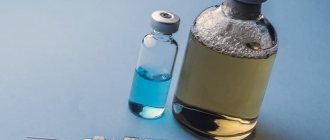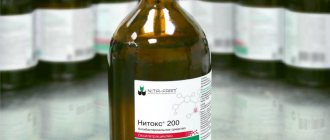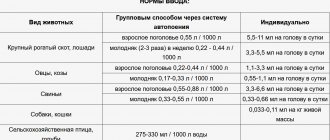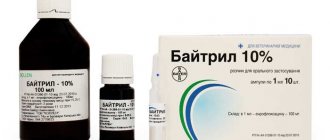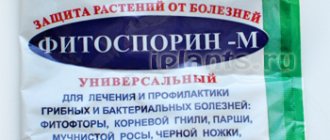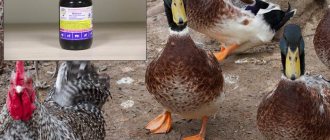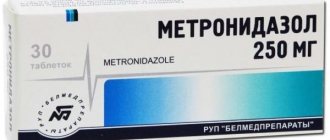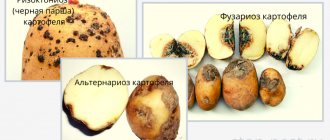Tetramizole 10 for birds is a medicine for helminthic infestations, produced in powder form, in which the mass fraction of the active substance is 10%. It is used in the form of aqueous solutions, which are consumed by birds along with food or instilled into the beak with a syringe. The drug is packaged in various packages from 50 g to 5 kg.
Indications are any helminthic infestations of chickens caused by roundworms (nematodes). Tetramizole is also used to prevent mass infection by nematodes. If one bird shows signs of illness, it is recommended to give the medicine to all.
Description of anthelmintic
The use of the drug is resorted to when it is necessary to remove parasites from the body of living creatures. Tetramizole actively affects all types of annelids.
The drug is prescribed for diseases:
- For sheep, cattle:
- bunostomosis;
- cooperation;
- nematodirosis;
- habertiosis;
- strongyloidiasis;
- hemonchiosis, etc.
- For pigs:
- esophagostomosis;
- trichocephalosis;
- ascariasis;
- strongyloidiasis;
- metastrongylosis.
- For birds:
- syngamosis;
- heterokidosis;
- amidostomiasis;
- capillariasis.
Tetramizole 10% is produced in the form of yellow granulate and white powder, soluble in water. Its active substance consists of 2 isomers, in active and inactive form. The product acts against nematodes, worms that parasitize the lungs, stomach and intestines of the animal.
Tetramizole affects the cholinomimetic activity of the central nervous system and ganglia of worms, causing their paralysis and death.
The drug has a good absorption rate into the digestive tract and remains in the body for at least 1 day. The drug is excreted from the animal’s body through feces and urine.
Treatment of worms in laying hens - Alben or Tetramizole?
Both drugs have a pronounced anthelmintic effect. They differ in the active substance, but in both cases they can be used to treat helminthiasis in laying hens.
Tetramizole is available in powder form, which makes mixing the medicine with water a little easier.
However, Alben can be crushed independently by mixing with water or food. In terms of toxicity, they are approximately the same, so they have no visible advantages over each other.
As for Alben, there is one important clarification. Its use is not recommended if laying hens are kept in enterprises or farms, i.e.
eggs are intended for further sale. As for personal consumption, eggs can be eaten after four days from the date of taking the drug. After taking Tetramizole you will also have to wait four days.
Instructions for use of Tetramizole 10
To use the drug Tetramizole to other animals that are not listed in the instructions, you must consult a veterinarian.
Tetramizole in the form of granules is given to livestock in the morning. Taking the drug does not require special preparation or diet. The medicine is administered orally with water and food.
The anthelmintic agent is used once. Repeated use is contraindicated. The active substance of the drug is a relatively toxic compound.
The drug is diluted with water and injected into the throat of livestock or other living creatures using a syringe or special devices for injecting liquid.
If an anthelmintic drug needs to be used for a large number of livestock, testing is first done on several animals, preferably 5. If animals have a weakened immune system or are taking other medications, side effects may occur.
Preparation for pigs
According to the instructions for use, Tetramizole 10 for pigs is calculated as follows: 100 mg of medication per 1 kg of weight. But, the maximum dose for one animal is 45 g.
Exceeding the prescribed dosage will lead to unpleasant consequences. If treatment is carried out on a large number of pigs, then the drug is added to food: 1.5 g per 10 kg of animal weight. There should be enough feed for the livestock to eat it within an hour.
It is necessary to give Tetramizole to piglets of approximately the same weight, so that there is enough space near the trough for each baby. Weak piglets are fed separately so that they can eat the required amount of medicine.
Tetramizole for cattle
For cattle dosage: 80 mg per 1 kg.
It is better to treat adult livestock before moving it to a new pasture, into a closed enclosure or room. The medicine is given to young animals 1.5-2 months after they begin to be taken out to pasture. For sheep, according to the instructions for use, Tetramizole 10% is calculated per 1 kg - 75 mg.
Dosage for poultry
Tetramizole 10% for birds is given at the rate of: per 1 kg – 200 mg. The product is injected into birds with a syringe; mixing it with food is prohibited.
The drug is available in 2 forms: 10% and 20%. Tetramizole 20% for sheep, cattle, pigs and poultry is used in exactly the same way as 10%, only all doses described above in the instructions must be divided by 2.
If the medicine is used for animals that produce milk, then after milking the first day the products are simply poured out. Animals that have undergone anthelmintic treatment should be slaughtered a week after the procedure.
How to tell if farm birds have worms
It is not difficult to determine that poultry have worms. The main thing is to pay attention to the following symptoms:
- your pets begin to rapidly lose weight;
- the number of eggs decreases, while their shell becomes soft or very fragile;
- excrement becomes liquid and acquires a yellow tint;
- birds become lethargic, lacking energy and severely inhibited;
- in some cases there is loss of appetite;
- In turkeys and chickens, a faded comb can be observed.
In order to prevent or eliminate symptoms that have already appeared, veterinarians recommend using the drug Tetramizole 10. The instructions for use for birds call it an excellent assistant in the fight against worms. The main condition is to start treatment on time.
The most common type of farming in the country is pig farming. Pigs are easy to raise and keep; they are capable of producing not only high-quality meat, but also tasty lard. These are first-class animals for starting your own business, but their weakness is worms.
Animals love to roll in the mud and eat absolutely everything in the enclosure. This causes helminth eggs or larvae to enter their body, which affects the pig itself.
To protect or cure pigs from this disease, a potent drug such as Tetramizole 10 is needed.
This drug has a number of active ingredients, the basis of the drug is Tetramizole. This is a powerful nematicide with wide functionality. Thanks to it, the medicine is able to fight not only adult individuals, but also the larvae of helminths and nematodes.
The substance is dispensed in the form of small granules. The powder is white in color and has a barely noticeable odor. Tetramizole 10 can quickly rid pigs of worms at home, without the help of a veterinarian.
The effectiveness of the drug directly depends on the correct dosage.
The note! If you sell live pigs, you simply need to ensure that the animals do not lose weight, therefore treatment and prevention of helminths using Tetramizole 10 is a necessary procedure.
The substance is taken orally. It is given to pigs either diluted with water or added to wet food. The mixture is thoroughly mixed and poured into the trough. Use Tetramizole 10 in the morning, along with the mash.
At this moment, the animal is hungry, and therefore will eat absolutely all the food from the feeder, which guarantees the high effectiveness of the medicine. The dosage is very simple. For every 10 kg of pig weight, you need to give it 1.5 g of pellets.
It is very important to adhere to these indicators, since an overdose of the drug can cause a number of serious complications.
Important! The maximum amount of Tetramizole 10 per head is 45 g. If you exceed this mark, it can cause allergic reactions in the animal.
Use group administration of the drug. In this case, it is necessary to ensure that all piglets have enough space at the trough to receive the same dose of the substance.
But the group treatment method is not suitable in cases where there are sick or weakened animals in the herd.
Such pigs must be separated from the rest of the litter and fed individually in order to achieve maximum results from Tetramizole 10.
Medicine for pregnant queens is given 3 weeks before farrowing; in the later period, the substance ceases to have any effect on the pig’s body.
If you do not use the medicine at all, there is a high probability that helminths or pulmonary nematodes will infect the still-born brood, which will significantly complicate treatment.
2 weeks after giving birth, the sow and her young animals are transferred to a clean barn, and the barn is treated with lime in order to get rid of worms that came out of the pig’s body after using the drug.
The note! The medicinal substance has a wide spectrum of action; it treats livestock and poultry against helminths, in accordance with the instructions.
Pigs are treated with Tetramizole 10 once a year, at 4-6 years of age. After the first use of ten percent tetramizole, did you notice any changes? Use a stronger concentrate of the drug - Tetramizole 20.
Side effects
Most experienced pig breeders note that the medicine has almost no side effects, although in veterinary medicine there have been cases of individual allergic effects of the substance, which were due to the characteristics of the pig’s immune system. Basically, the negative effect of the drug manifests itself after exceeding the dose, which is affected by the same allergic reactions.
Notes
There are a number of notes on the use of the drug that must be followed so as not to harm yourself and the animal.
- Do not mix the medicine with other substances, as this may cause an allergic reaction.
- Did you start diluting Tetramizole 10 in water and the solution got into your eyes? It is necessary to rinse them immediately with warm water to prevent burning the retina.
- After the procedure, you must wash your hands thoroughly; the potent substance tetramizole can cause dry skin due to its complete degreasing.
- You can inject pigs 3-4 days after using the medicine.
Proper treatment will give positive results in the first hours. Tetramizole 10 is suitable for absolutely all breeds of pigs, be it Yorkshire, Duroc, Vietnamese Fold, Large White or any other. The drug also treats large and small livestock and poultry.
The shelf life of the substance is 5 years, provided that it is properly stored in a dry place, away from sunlight. You should keep the drug away from children. Storage temperature should not exceed 30 degrees.
Despite the large and detailed instructions for Tetramizole 10, there are still a number of most asked questions regarding this drug.
- Is it better to dilute the powder with water or mash?
- The ideal option is a mash: a portion that the pigs will eat within an hour.
- How many times a day should I give the drug?
- The medicine is administered once, and then the animal is monitored. If there are no results, the procedure can be repeated after 3 days.
- How much is Tetramosyl 10 in a teaspoon?
- Like any other drug - approximately 5 g.
- What is the method of using medicine with water?
- The pig's head is raised slightly upward, a dosing syringe is inserted into the throat and the drug is forcibly injected into the body. Effective, but not the easiest way.
- What is the price of the substance on the market?
- From 2.5 to 5 dollars, depending on volume.
- How to weigh pellets correctly?
- Use electronic scales.
That's all you need to know about Tetramizole 10. Now you know how to give the medicine, how to store it and how to use the drug correctly without harm to yourself and the animal.
The most common type of farming in the country is pig farming. Pigs are easy to raise and keep; they are capable of producing not only high-quality meat, but also tasty lard. These are first-class animals for starting your own business, but their weakness is worms. Animals love to roll in the mud and eat absolutely everything in the enclosure.
In every agricultural or farming enterprise, sooner or later there comes a need to treat animals for parasites and worms. For these purposes, scientists have developed a special harmless drug “Tetramizole 10”, which can be used for birds, pigs and cattle. The main thing is to know how much the medication is and carefully monitor the dosage!
Tetramizole 10 is an innovative drug in the form of powder or granules, which helps in the treatment and prevention of pets not only from helminths, but also from the following misfortunes:
- Dictyocaulosis;
- Hemonchoz;
- Bunostomiasis;
- Nematodirosis;
- Ostertagiasis;
- Habertiosis;
- Cooperiosis;
- Strongyloidiasis;
- Ascariasis;
- Esophagostomosis;
- Strongyloidiasis;
- Trichocephalosis. Application of Tetramizole for pigs
You can buy Tetramizole 10 in different packages at a veterinary pharmacy or veterinary clinic. It is sold both in small, sealed boxes of 100 g, and in foil bags from 150 g to 1 kg (capsules). For owners of large livestock, medicine packaged in 10 kg plastic buckets is suitable.
Note! The drug contains an effective anthelmintic that can affect the nervous system of parasites and cause complete paralysis in them. Open packaging can be stored for up to five years in a dark place. The active component of the drug is tetramizole chloride.
After taking the powder, it is absorbed very quickly and begins to act as effectively as possible, destroying helminths.
The very next day it is excreted from the body along with urine and, partially, feces. In addition to exterminating worms, Tetramizole 10 has a therapeutic effect on areas that have been affected by parasites.
After taking it, you can notice an increased appetite and better absorption of feed by livestock.
Amprolium: instructions for use for broiler chickens
The deworming drug for pigs must be added to the warm morning feed at the rate of 0.15 g/kg body weight. Tetramizole for piglets, the dosage is half the specified norm. Sows are prohibited from taking the medicine later than two weeks before farrowing.
The instructions for using the drug "Tetramizole 20" for pigs are almost identical. Capsules should be used in the same way as powder, mixed into feed, at a dosage of 5g/100kg of weight.
For single pig treatment, the required dose is mixed with water and given to the animal through a tube or in a bottle. It can be mixed with warm food until smooth with the addition of the required amount of water.
Note! Tetramizole for pigs is taken with the first meal, which should last no more than an hour!
Simultaneous treatment/prevention of the entire herd on the farm is also allowed. To do this, powder or granules are mixed with feed and given into a common trough.
Dosing is calculated similarly, based on the total weight of the pigs. During a general reception, all livestock should be given free access to the trough.
Weak pigs or piglets need to be handled separately so that they take a sufficient amount of Tetramisole 10.
Side effects
Contraindications and side effects
Tetramizole in veterinary medicine is used according to the instructions; any non-compliance with it can lead to the appearance of desired consequences.
If the recommended dosage is exceeded, the following phenomena may occur:
- diarrhea;
- muscle tremors;
- profuse salivation.
Contraindications to the use of the drug may be the following:
- diseases of infectious etiology;
- liver and kidney dysfunction;
- pregnancy (last trimester);
- simultaneous use of other anthelmintic drugs.
Tetramizole 10%, 20% is not used for rabbits, dogs, cats, horses. It is better to consult a veterinarian regarding the use of the drug in these animals. The instructions do not contain a clear dosage for these groups, so it is impossible to correctly calculate this yourself.
Dosage
Before using the medicine, you do not need to go on a starvation diet or use laxatives. Tetramizole is given once, orally, it can be given to one animal or to a group with morning feed, observing the following doses:
| Animals | Dosage of active substance (mg/kg) | Tetramisole | |
| 10% | 20% | ||
| Cattle | 8,0 | 80,0 | 40,0 |
| MRS | 7,5 | 75,0 | 37,5 |
| Pig | 10,0 | 100,0 | 50,0 |
| Birds | 20,0 | 200,0 | 100,0 |
If it is necessary to give an anthelmintic to one animal, then prepare a solution and use a dispenser to administer the medicine by mouth. In group cases, samples are made for the entire population, mixed well with food (calculation of 50-100 grams of food per head or 5 g for birds). The mixture must be placed in feeders and the animals must have free access to them.
If mass deworming of animals is carried out, it is recommended to test each batch of the drug on a small number of cattle (from 5 heads). If after 2-3 days no complications are noticed, then it can be fed to all animals.
Symptoms of worms in birds
It is easy to determine the presence of parasites in birds based on a number of signs.
The drug Tetramizole 10
Mainly noted:
- developmental delay;
- sickly appearance;
- lethargy, weakness;
- refusal of food;
- severe exhaustion;
- wheezing when breathing;
- paralysis and seizures;
- decreased egg production;
- change in the color and consistency of the droppings (greenish, yellowish, liquid).
Even the presence of several symptoms should alert you. It is recommended that the sick animal be shown to a veterinarian, but in any case, anthelmintic therapy will be necessary.
Application
Ascariasis
Symptoms of the acute form: loss of appetite, liquid droppings, pale mucous membranes of the comb, limbs, ruffled plumage, lethargy, vomiting Read
Amidostomiasis
Symptoms of the acute form: apathy, general weakness, decreased or lack of appetite, breathing problems, unsteady gait, retarded growth and development Read
Syngamosis
Symptoms: sneezing, coughing, neck stretching, beak wide opening, head shaking Read
Capillariasis
Symptoms: loss of appetite, lethargy, diarrhea, trembling, weight loss, death Read
Heteracidosis
Symptoms: indigestion, diarrhea, loss of appetite, lethargy, decreased egg production, retarded growth and development Read
Treatment and prevention of parasitic diseases in chickens, such as ascariasis, amidostomiasis, syngamosis, heteracidosis, capillariasis, caused by nematodes, is carried out according to one algorithm:
- 400 mg of the drug is diluted in 1 liter of water, given individually orally (through the beak) at a dose of 40-50 mg/kg of bird weight or to the entire flock instead of drinking once;
- the powder is given at the rate of: 10% tetramizole - 0.2 g (200 mg)/kg of bird weight, 20% tetramizole - 0.1 g (100 mg)/kg of weight or 5 g of powder mixed with 100 g of dry feed per bird, given once. The food is laid out in feeders taking into account the free access of birds to them;
- granulate – 1 g/5 kg of poultry weight with feed one time;
- Before deworming or prophylaxis, a preliminary starvation diet and laxatives are not required.
This scheme of drug use is suitable for poultry during the second growing period - after 8 weeks.
For chickens, the drug is calculated based on body weight.
When prescribing tetramizole to laying hens, broiler chickens and adult crosses, there are no special instructions.
Before mass use, the drug is tested on a group of birds (10-100 individuals) of different weights and ages. If there are no side effects on the bird’s body, the drug is given to the entire flock within three days.
It is important to disinfect the chicken coop, feeders, perches and nests before starting treatment to prevent relapse of the disease.
Indications for use of Tetramizole
The medicine has a nematode effect on the animal body and helps to cope with a number of parasites, including:
Tetramizole powder
The composition is laid out evenly in the feeders so that all animals have access to it.
The piglets should be approximately the same weight if they are fed together. Weakened individuals need to be fed and treated separately.
Pregnant sows are treated approximately 3 weeks before farrowing. After use, animals are washed to remove helminth eggs from the skin.
Special applications
During treatment or carrying out preventive measures using Tetramizole 10, a number of precautions must be observed:
- Since the medicine is moderately toxic for use in warm-blooded animals according to hazard class III, compliance with the therapeutic dosage does not cause embryotoxic, terratogenic and mutagenic effects.
- Slaughter of pigs for meat purposes that have undergone deworming is permitted only 10 days after all activities have been completed.
- If there is a need to slaughter animals prematurely before the specified period, then the meat can be used exclusively as feed for carnivorous animals. Usually meat and bone meal is produced or the product is sent to feed fur-bearing animals.
- During treatment, the drug may come into contact with the mucous membrane of the eyes or skin. In this case, you will need to rinse the affected area with large volumes of water.
- After carrying out the work, wash your hands thoroughly under running water, although it is advisable to use protective gloves during the manipulation process.
Important! If the treatment is carried out correctly, the effect will be achieved within the next few hours after using the product. The drug is suitable for all breeds and crossbreeds of pigs.
The drug "Tetramizole": composition and release form
Tetramisole is a water-soluble anthelmintic intended for cattle, sheep, pigs and poultry. The medicine is produced in the form of a homogeneous powder, the color of which can vary from white to yellowish-gray, or in granules of a dirty yellow hue.
The granule size is in the range of 0.2 – 3 mm. The medicine is packaged, regardless of the release form, in plastic-coated bags, as well as jars of 50 g, 100 g, 150 g, 200 g, 250 g, 500 g, 1 kg, 5 kg.
Form, composition
TETRAMIZOL 10% and 20% water-soluble powder contains 100 or 200 mg of tetramizole hydrochloride as active ingredient in 1 g, respectively.
TETRAMIZOL 10% and 20% is produced in the form of a homogeneous powder according to
- 50;
- 100;
- 150;
- 200;
- 250;
- 500;
- 1000;
- 5000 and 10000 g.
in double plastic bags, polyethylene-coated paper bags, plastic cans or plastic buckets.
Pharmacological action and indications for use
The active substance of the drug, when ingested, blocks the action of fumarate reductase and succinate reductase in the body of the parasite, and also simultaneously provokes cholinomimetic activity of the ganglia and the central nervous system. As a result of these complex biochemical processes, the worm begins to become paralyzed, after which it dies.
Veterinarians note the wide spectrum of action of Tetramizole for chickens and other domestic animals. The anthelmintic is active in the areas of the lungs and gastrointestinal tract. Nematodes of the following types are sensitive to its main constituent substances: Oesophagostomum, Nematodirus, Haemonchus, Ostertagia, Capillaria, Ascaris suum, Metastrongylus, Trichostrongylus, Cooperia, Ascar >
The peculiarity of the drug is its ability to be quickly absorbed from the stomach and intestines. In this case, the maximum concentration of the drug in organs and tissues is achieved within one hour and is maintained throughout the day. The drug is eliminated from the body through urine and feces.
Application
- Parasites
- Infectious
Coccidiosis
Symptoms of the acute form: thirst, loss of appetite, swelling, bloody droppings, anemia, weakness, loss of coordination Read
Salmonellosis
Symptoms of the acute form: depression, loss of appetite, diarrhea, wheezing when breathing. Read
Mycoplasmosis
Symptoms of the acute form: shortness of breath, sneezing, wheezing in the trachea, redness of the eyes and foamy discharge from them, decreased appetite and egg production Read
Salmonellosis (pullorosis)
Dosage and method of administration for adult birds:
- when adult chickens are sick with salmonellosis, 1 (50 mg) tablet of furazolidone is dissolved in 3 liters of water and the flock is fed at the rate of 4 mg of the drug per 1 kg of live weight for 3 weeks. At the same time, streptomycin is given mixed with the feed at a dosage of 1000 units/1 kg of feed;
- The form of the drug can be any (tablets, powder). The medicine is dissolved in water or given along with food. The tablets have poor solubility: first they are mixed with a few drops of alcohol, and then water is added to the required amount. You can dilute the medicine in hot water;
- feed or drink furazolidone at intervals of 4-6 hours.
There are no specific uses for laying hens.
Dosage and method of application for chickens:
- chickens are prescribed a dosage of 3 g per 1000 birds for 5-7 days;
- For greater effectiveness, the antibiotic is given to chickens in the form of a powder dissolved in water.
Broiler chickens are given furazolidone according to the following scheme:
- at the rate of 4 mg of medication per 1 kg of weight for 5 days;
- 7 days break with simultaneous feeding of the vitamin complex for 3 days;
- on the eighth day, the course of taking the medication is resumed;
- The medicine is mixed with food or drunk with water.
For adult cross-breeds, the drug is prescribed at a dosage of 4-5 mg per 1 kg of weight and is stopped 5 days before slaughter.
Coccidiosis
Dosage and method of administration for adult birds:
- 3 mg of the drug per head for 6-9 days, 2 times a day;
- The tablets are crushed and mixed into the food or the powder is diluted in water. Give with drink or during feeding.
Dosage and method of application for chickens:
- up to one week of age - 3 mg per 1 kg of live weight with food or water twice a day;
- for two-week-old chickens - 1 tablet of antibiotic is dissolved in 100 ml of water and given with drink.
Features of use for broiler chickens:
- from the first to the second week, furazolidone is prescribed in the amount of 2 mg per 1 head;
- from 2 weeks of age - 3 mg per 1 individual.
There are no special indications for use in adult broilers.
Mycoplasmosis
Dosage and method of administration for adult birds:
- For adults, the drug is prescribed at a dose of 5 mg per 1 kg of body weight in combination with other antibiotics;
- duration of use is 3-9 days, 2 times a day;
- fed with food in crushed form or given with water.
There are no specific requirements for prescribing antibiotics for laying hens.
Dosage and method of application for chickens:
- for chickens from one week of age to two months, the drug is prescribed twice a day at a dose of 2 mg per chicken;
- It is more effective to solder the drug in the form of an aqueous solution.
Features of use for broiler chickens:
- for mycoplasmosis in broiler chickens, the drug is prescribed in an amount of 3 mg per 1 kg of weight;
- treatment is continued for 5-8 days, 2 times a day;
- The medicine is given in the form of a powder diluted in water.
For adults, 5 mg of the drug is prescribed per 1 kg of weight. 5 days before slaughter, the medication is stopped.
Symptoms of worms in birds
Poultry kept in closed enclosures is less susceptible to attacks by parasitic organisms. Animals that have free range are more likely to become infected, especially young animals. The appearance of parasites is indicated by a rapid decrease in the weight of the bird, the appearance of soft shells on the eggs, liquid yellow feces, lack of activity, sickly appearance, and lethargy. Turkeys and chickens' combs become pale.
The manifestation of worms can vary depending on their type and the organs in which they function. Most often, the stomach, intestines, lungs and oviductal canal are affected by helminths. The danger of infection is that worm larvae are able to penetrate eggs and infect people who eat them. Therefore, experts recommend avoiding any poultry products if you have helminthiasis.
Disease Prevention
Providing adequate nutrition for birds and keeping them clean will make it possible to reduce the incidence of disease among chickens and chickens. It would be better to prevent the disease than to treat it for a long time in the future or to slaughter the bird if treatment is ineffective.
Complete feed for laying hens PK 1-1 and PK 1-2
Balanced feed for chickens and young animals PC 2 and PC 3
Balanced diet for the formation of the oviduct in chickens PK-4
Compound feed for broilers: Start, Growth, Finish PC 5
Brooder for chickens: Review of the best models in different price segments TOP-9
TOP 9 cages for chickens: models for amateur, farm and professional use Rating
Rating of chicken coops: mini, medium and large TOP-9
The best drinkers for chickens: vacuum, nipple, mounted, float and siphon Rating
Instructions: dosage and method of administration
"Tetramizole" 20% and 10%, according to the instructions, does not require additional preparation before use in the form of diets and the use of laxatives. In cases of illness, therapy is carried out once during the morning meal. If there is a need to treat one bird, the drug is diluted with water and administered using a dispenser into the bird’s beak.
Be careful: “Tetramizole” for chickens has a number of contraindications , so before calculating the dose, carefully read the manufacturer’s recommendations. Please note that the permissible dose of the drug for chickens and other birds is 20 mg of active substance per 1 kg of live weight.
During group deworming of livestock, a measured dose of medication is mixed with feed and poured into feeders with free access. There should be 50–100 g of mixture per bird.
Before giving Tetramizole to poultry en masse, test each batch of the drug on a small group of birds. If within 3 days the tested individuals have no complications or adverse reactions, you can begin deworming the remaining birds.
Conditions and shelf life
With caution. In a dry place, protected from direct sunlight and out of reach of children and animals. Separated from food and feed at a temperature not exceeding 30 ºС. Shelf life: 2.5 years.
Manufacturer: Veterina Ltd. (Veterina Ltd.), Croatia.
Tetramizole is stored for 4 years in a dry, cool place, in the dark. Storage at temperatures above 30 degrees is unacceptable.
Tetramizole effectively destroys worms in the body of birds in just one application.
- Use the product not only for treatment, but also for prevention, especially if chickens do not live in cages. This is due to the danger of chickens becoming infected with worms from each other (if one individual shows signs of infestation, there is a high probability that it has managed to infect the others).
- Begin mass application after the drug has been tested on one individual (in small farms) or on a group of individuals (in large farms).
- There is controversy regarding the use of the drug. Some veterinarians advise not to mix the medicine into the food and, even with mass use, to bury each individual in the beak with water.
- To ensure that the product remains effective for a long time, store it along with other medications for animals in a separate refrigerator.
Thus, tetramizole is a drug against parasitic roundworms (nematodes). Effective against capillaries, roundworms and other worms that infect birds. A single application is enough to completely expel parasites. It is used by instilling 5 g of the substance per 2 kg of weight into the beak with a syringe.

